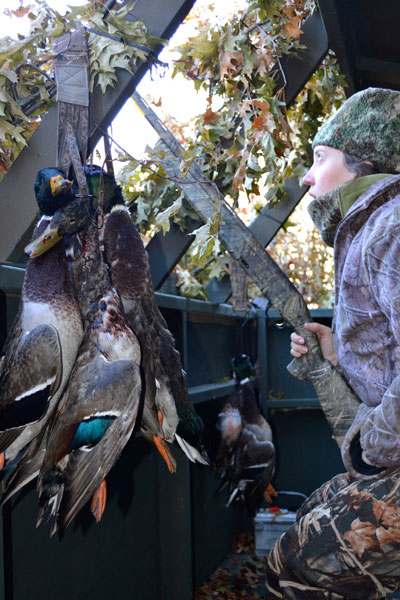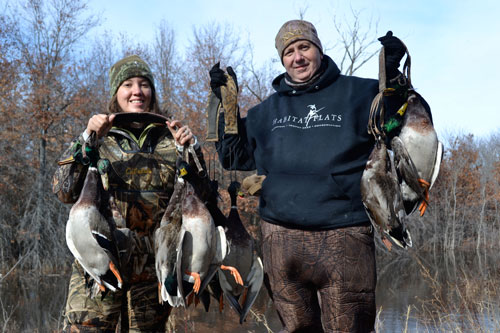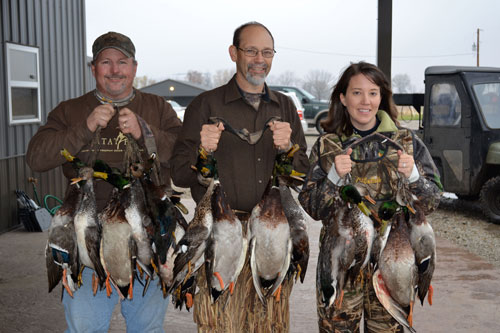 It was one of those rare sights a waterfowler’s dreams are made of: thousands of ducks descending on a cornfield as the sun sets, jostling for space to land, tornadoing like they thought they were snow geese. Even better — I was watching this spectacle from the porch of a great duck lodge.
It was one of those rare sights a waterfowler’s dreams are made of: thousands of ducks descending on a cornfield as the sun sets, jostling for space to land, tornadoing like they thought they were snow geese. Even better — I was watching this spectacle from the porch of a great duck lodge.
“Probably about 10,000 ducks in that field, if I had to guess,” said Tony Vandemore, co-owner of Habitat Flats. “I think we’ll send a group of hunters out there in the morning.”
Tony grinned the satisfied smile of a man who is reaping the feathered rewards of a long labor of love. He and co-owners Ira McCauley, Aaron McCauley and Dan Daugherity have poured countless man-hours into this land, this lodge, this dream, for the past five years. It’s paying off.
Located in north-central Missouri in an area known to waterfowlers as the “golden triangle,” Habitat Flats is near Fountain Grove Conservation Area, Swan Lake National Wildlife Refuge, Grand Pass Conservation Area, Dalton Cutoff and the Missouri River. The area’s excellent habitat winters a staggering number of birds, and I visited in November to get in on the action.
On the first morning, I waded to a permanent blind on Love Lake with guides Tony and Kelly Moore and a fellow hunter, Phil. As the mallards dropped in in droves, we easily shot a four-man limit before 9:30 over a modest spread of GHG decoys and couple MOJOs. Back to the lodge for a nap and lunch — the camp chef owns a gourmet restaurant in town, so meals are a big deal at Habitat Flats — and watching the sun set over the aforementioned field of tornadoing ducks.
The next morning brought icy drizzle and freezing temperatures, and we decided to go old-school and tough out the weather on the banks of a little slough. No blinds, no protection — just a girl and her gun leaning against a tree in what Tony cheerfully called “the Hell Hole.” We nailed some mallards in the rain, early, then a woodie dropped in and fell to my shot, and Phil nailed a passing greenwing. The action slowed as the sun came out, and we crossed the slough and picked out new trees to hide under and shoot from the other direction until we filled our limits.
Day three. Phil had gone home, so Tony and I trudged through the timber with guide Mike Abbadessa and a still-in-training pup named Junior to a new blind nicknamed The Cemetery. Shortly after sunup I became the first hunter to kill a duck out of that blind, and we had a three-man limit of fat mallards in short order. Is there any sight in a hunter’s world more exhilarating than the sun glinting off a greenhead with his wings cupped, feet down, dropping in without hesitation?
 Duck hunters love the process — the getting up early, the predawn decoy sets, the eternal hope of watching a flock that circles and circles and circles. But when you get down to it, it’s a numbers game, and we want to see lots of ducks and have a good chance to limit out. And the numbers game is where Missouri’s golden triangle really shines.
Duck hunters love the process — the getting up early, the predawn decoy sets, the eternal hope of watching a flock that circles and circles and circles. But when you get down to it, it’s a numbers game, and we want to see lots of ducks and have a good chance to limit out. And the numbers game is where Missouri’s golden triangle really shines.
Vandemore and crew flood more than 2,000 acres and have access to more than 50,000 acres of dry fields. “We strive for diversity with our habitat management efforts, because the ducks’ nutritional needs change throughout the season based on the weather,” says Tony. Habitat Flats’ crew plants chiwapa millet, Japanese millet and buckwheat for the early season and do moist soil drawdowns at the right times of year to promote good natural vegetation. They also plant a lot of corn and some rice to feed ducks when the weather turns cold, and they utilize careful mowing and flooding strategies to promote excellent invertebrate blooms.
Pressure management is big at Habitat Flats. They have 44 pits and above-water timber-frame blinds, and on any given day (at full capacity), more than 85 percent of those spots are being rested as a refuge for ducks. “To have and hold ducks throughout the course of a season, you have to have diversification in your food sources, and the birds have to have rest and places they are not hunted,” says Tony.
 Missouri’s golden triangle sees (and holds) so many birds because ducks aren’t flying as far south as they used to, and according to Tony, the area is wintering more and more birds every year. If a mixed bag or something out of the ordinary is your preference, you can take your pick at Habitat Flats. You can hunt flooded timber, oxbow sloughs, standing flooded corn fields, other flooded agricultural fields, managed moist soil marshes, dry agricultural fields, rivers and creeks. Those 50,000 acres of dry fields are a boon to snow goose hunters in the spring conservation season, and the no-limit snow goose hunting at Habitat Flats is legendary.
Missouri’s golden triangle sees (and holds) so many birds because ducks aren’t flying as far south as they used to, and according to Tony, the area is wintering more and more birds every year. If a mixed bag or something out of the ordinary is your preference, you can take your pick at Habitat Flats. You can hunt flooded timber, oxbow sloughs, standing flooded corn fields, other flooded agricultural fields, managed moist soil marshes, dry agricultural fields, rivers and creeks. Those 50,000 acres of dry fields are a boon to snow goose hunters in the spring conservation season, and the no-limit snow goose hunting at Habitat Flats is legendary.
Though I had great success here, I never did get to hunt that massive field behind the lodge with the tornadoing ducks. Sounds like a reason to go back!
Habitat Flats
(660) 734-3195
www.youtube.com/user/HabitatFlats






